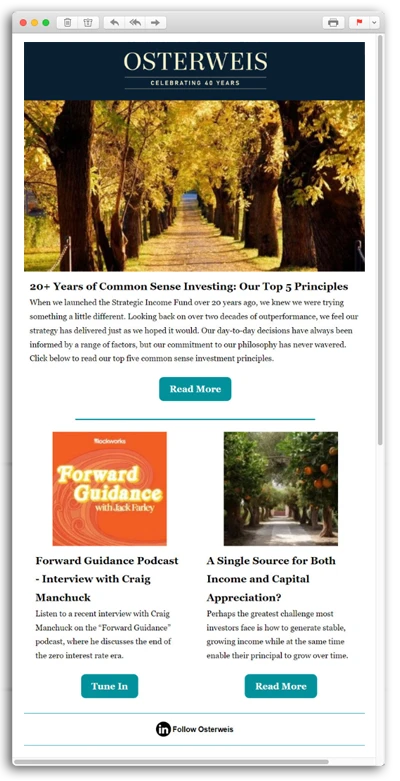Magic 8-Ball Says, “Ask Again Later”
Given the significant policy changes coming from Washington recently, uncertainty about the economic outlook has increased, not decreased. Thus, it seems apropos to continue with our Magic 8-Ball theme from last quarter. Post the quarter close, we experienced a market convulsion following the “Liberation Day” (LD) tariff announcements, which left investors holding their breath, waiting for what comes next. As the fog surrounding the future continues to thicken, businesses are struggling to make long-term plans, just as investors are struggling to make portfolio decisions. It is a tumultuous time, but we believe a calm head is the order of the day. Investors need to be patient and wait until there is more visibility before making any big decisions. As the Magic 8-Ball Says, “Ask Again Later.”
Stomach-churning volatility has been the dominant theme so far this year, with the S&P 500 losing 4.3% in the first quarter and falling 8.5% from its post-inauguration peak on February 19th through the end of March. And, of course, losses accelerated markedly post-LD. In the first two trading days following the announcement, the S&P 500 lost over 10%. Fixed income fared a little better during the first quarter, as capital rotated out of equities and into bonds. The yield on 10-year Treasuries dropped to 4.21% at quarter-end versus 4.57% at year-end, and it continues to drop further post-LD. 30-year Treasuries followed a similar pattern. High yield (which has been a very attractive asset class over time, as we discussed in our last Outlook) was also a calm port in the storm, with the ICE BofA U.S. High Yield Index returning 0.94% for the quarter. While high yield has been a bit weaker post-LD, with yields rising, we expect it should recover over the course of the year, as it has done historically following selloffs of this nature.
Jim Bianco of Bianco Research recently coined the term “Global Economic Realignment” to describe the disruptive actions coming from Washington. It seems that the tariffs are designed to compel deglobalization with a goal of making the U.S. the winner of all trade battles. President Trump is simultaneously attempting massive deregulation, reversing past immigration policies, reducing trade deficits, and slashing government spending – a very tall order. Many of these actions could have unintended consequences, and we may not know what they are for some time. The Fed, like most of us, is stuck in the middle, trying to figure out whether to stave off rising inflation by raising rates or to stimulate possible weaker demand following the LD announcement. So far, they have elected to wait and see what actually happens before acting. We think this is the right strategy, and it is consistent with our own approach, as we have become more defensive and decreased our exposure to longer-dated assets while looking for better yields. Perhaps the Fed should consult with the Magic 8-Ball?
Everyone agrees that reducing overbearing regulations, wasteful government spending, and fraud is an admirable goal, and some would even agree that temporarily choking off economic growth to achieve it would be acceptable. However, implementation to date has caused quite a bit of turmoil, and many of the budget and personnel cuts have been stalled or reversed due to ongoing litigation. Can this haphazard belt-tightening program truly save the $1+ trillion that the administration is targeting? This may turn out to be the largest Kabuki theater production of all time, with lots of plot twists and much less to show for it in the final reckoning. Perhaps the Fed and the bond markets are seeing through this façade? Maybe this is why fixed income is holding up better than equities, which are dominated by algorithmic and passive investing, both of which are largely headline-driven.
Labor markets have remained healthy, which has been a stabilizing force amidst the rising uncertainty. It should be noted that a fair number of government workers took buyouts and early retirement, but depending on their pensions and other benefits, their removal may not save the federal government much money going forward. Also, those workers do not file for unemployment benefits, so the unemployment rate may be modestly understated. Bianco recently noted that on March 11th the U.S. Economic Policy Uncertainty index hit its highest level in 40 years! According to Jim, “Uncertainty was greater than 9/11, the Iraq War, the Global Financial Crisis, and the Covid-19 shutdown.” Is the current situation really as extreme as those prior periods? Only time will tell, which seems to be the best antidote for uncertainty.
Retail sales have trended sideways over the last 12 months, so the consumer is still spending. But according to Wells Fargo economists, “Consumer sentiment has not been this low since the high-inflation days of 2022. Unlike that era, however, consumers now see rising prices as more than a passing phase. In a sign of these entrenched expectations, long-term inflation expectations rose to their highest since 1993.” The February PCE Index (a measure of consumer price inflation) showed a continued rise in prices. Nick Timiraos from The Wall Street Journal writes, “Consumers' year-ahead expectations of inflation rose in March in the Conference Board survey. These expectations steadily declined last year but have risen in each of the last three months.” In addition, per The King Report, “Conference Board 12-month inflation expectation is now 6.2%. Are expectations getting anchored?” High Frequency Economics reports that “In real terms, which is what matters for GDP and overall economic growth, real personal spending hardly grew at all in February and not by nearly enough to reverse its huge declines in January, declines which were revised larger than first reported.” All this may be why King reported that “Consumer Confidence tumbled to 92.9 in March from 100.1 … This is the lowest reading since January 2021.” Whether this actually sets the U.S. economy up for long-term growth is unknown. However, if the fears of inflation do materialize, as they did post-Covid, companies will raise prices, which has a positive effect on profit growth, which is good for debt holders.
The U.S. trade deficit has been a major sticking point and a focus for the Trump administration. In his first term (Trump 1.0), China was the main target. Import tariffs of $380 billion were levied in 2018 and 2019, but there were many loopholes and workarounds. Manufacturers either moved production to other low-cost Asian countries or shipped Chinese products through those same countries and Mexico. To counter this in Trump 2.0, over $1.4 trillion of tariffs have been announced and they impact almost every continent, with a special focus on China, Mexico, Canada, and more recently, Europe. The first three countries are our largest individual trading partners, totaling over $2.1 trillion. Andy Laperriere at Piper Sandler raises the point that Trump negotiated and signed the USMCA as a replacement to NAFTA with zero tariffs on virtually all goods but now sees that deal as a rip-off. Not to be outdone (by his former self), Trump 2.0 added specialty tariffs on foreign steel, aluminum, and copper along with general tariffs across most of our trading partners. In Trump 1.0, China and its manufacturers absorbed most of the tariffs through their profit margins and a weaker currency, so U.S. consumers saw only small price impacts on most goods. But this time around, China’s economy is struggling, so they cannot afford to absorb the tariffs and will need to increase prices to customers throughout the supply chain. Moreover, China has already announced retaliatory tariffs after LD. Let the negotiations begin! During Trump 1.0, Europe wasn’t a big focus, but now it’s a major target. So far, we see Europe collectively pushing back and implementing their own retaliatory tariffs on U.S. exports. How might this end? The Magic 8-Ball says, “Ask Again Later.”
Reversing globalization is not something that happens overnight or with little cost. Rebuilding the U.S. infrastructure for a manufacturing and self-sufficiency renaissance will take years of planning and a major realignment of supply lines, not to mention undoing years of accumulated red tape at the state and local levels. With the current low unemployment rate in the U.S. and the general state of immigration in flux, unless manufacturers can somehow get through the regulatory hurdles and fully automate their factories, we will see an increase in cost and potentially prices to consumers. The administration’s attempt at purging the U.S. of illegal immigrants may put additional strain on many industries that have historically relied on them. Be it construction, farming, or food processing, there will need to be a natural replacement of workers if we are to become less reliant on cheap imports. America is not a source of cheap labor and has lost manufacturing jobs to other countries for almost a century. Reversing that may not be possible in a practical time frame.
The Federal debt is large and rising. While much smaller as a percentage of GDP than Japan, for example, reducing it seems to be a priority of the current administration. With Trump’s desire to extend his first administration's tax cuts that are set to expire this year and add more tax cuts that he promised on the campaign trail, it will likely be difficult to achieve. As Jim Bianco reports, interest costs on the national debt are over $1.1 trillion annually and total 40% more than spending on national defense. Niall Ferguson, writing in The Wall Street Journal, reminds us why this is a bad thing. Quoting from Adam Ferguson’s Essay on the History of Civil Society (1767), “The crucial threshold is the point where debt service exceeds defense spending, after which the centripetal forces of the aggregate debt burden tend to pull apart the geopolitical grip of a great power, leaving it vulnerable to military challenge.” Now we are not saying that the U.S. is going to have a military coup, but it highlights the fact that the U.S. might not have the flexibility or the resources it once had to respond to major crises. If foreign buyers go on a Treasury buying strike, we will need to find other buyers to fund our growing deficits, and likely the Fed will have to use its balance sheet once again.
Market volatility will hopefully abate, and as time passes, we will gain more clarity on the economic impact and repercussions of the administration’s actions. Clearly, there will be winners and losers. Given the changes occurring day-to-day and week-to-week, we are not interested in placing any short-term, one-way bets. Rather, we are focusing on playing defense in shorter maturity, higher quality bonds, which hopefully dampen near-term volatility while we search for value in longer-dated bonds. We believe the portfolio is in a good place until the fog clears. As has been the case for a while now, there is not enough incremental yield to justify going further out the curve, but that may be changing post-LD as investors fear the worst. Because we are maintaining plenty of dry powder, if we do get a meaningful correction in fixed income, we are well positioned to buy higher-yielding, longer-dated paper in solid companies at attractive prices. We thank you for your continued confidence in our management and look forward to hearing from you.
Carl Kaufman
Co-President, Co-Chief Executive Officer, Chief Investment Officer – Strategic Income & Managing Director – Fixed Income
Bradley Kane
Vice President & Portfolio Manager – Strategic Income
Craig Manchuck
Vice President & Portfolio Manager – Strategic Income
John Sheehan, CFA
Vice President & Portfolio Manager – Strategic Income
The Osterweis Funds are available by prospectus only. The Funds’ investment objectives, risks, charges, and expenses must be considered carefully before investing. The summary and statutory prospectuses contain this and other important information about the Funds. You may obtain a summary or statutory prospectus by calling toll free at (866) 236-0050, or by visiting www.osterweis.com/statpro. Please read the prospectus carefully before investing to ensure the Fund is appropriate for your goals and risk tolerance.
Mutual fund investing involves risk. Principal loss is possible.
The Osterweis Strategic Income Fund may invest in debt securities that are un-rated or rated below investment grade. Lower-rated securities may present an increased possibility of default, price volatility or illiquidity compared to higher-rated securities. The Fund may invest in foreign and emerging market securities, which involve greater volatility and political, economic and currency risks and differences in accounting methods. These risks may increase for emerging markets. Investments in debt securities typically decrease in value when interest rates rise. This risk is usually greater for longer-term debt securities. Small- and mid-capitalization companies tend to have limited liquidity and greater price volatility than large-capitalization companies. Higher turnover rates may result in increased transaction costs, which could impact performance. From time to time, the Fund may have concentrated positions in one or more sectors subjecting the Fund to sector emphasis risk. The Fund may invest in municipal securities which are subject to the risk of default.
Past performance does not guarantee future results.
This commentary contains the current opinions of the authors as of the date above, which are subject to change at any time, are not guaranteed, and should not be considered investment advice. This commentary has been distributed for informational purposes only and is not a recommendation or offer of any particular security, strategy, or investment product. Information contained herein has been obtained from sources believed to be reliable but is not guaranteed.
No part of this article may be reproduced in any form, or referred to in any other publication, without the express written permission of Osterweis Capital Management.
Current and future holdings are subject to risk.
Investment grade/non-investment grade (high yield) categories and credit ratings breakdowns are based on ratings from S&P, which is a private independent rating service that assigns grades to bonds to represent their credit quality. The issues are evaluated based on such factors as the bond issuer’s financial strength and its ability to pay a bond’s principal and interest in a timely fashion. S&P’s ratings are expressed as letters ranging from ‘AAA’, which is the highest grade, to ‘D’, which is the lowest grade. A rating of BBB- or higher is considered investment grade and a rating below BBB- is considered non-investment grade. Other credit ratings agencies include Moody’s and Fitch, each of whom may have different ratings systems and methodologies.
Performance data quoted represent past performance; past performance does not guarantee future results. The investment return and principal value of an investment will fluctuate so that an investor’s shares, when redeemed, may be worth more or less than their original cost. Current performance of the Fund may be higher or lower than the performance quoted. Performance data current to the most recent month end may be obtained by calling shareholder services toll free at (866) 236-0050.
A basis point is a unit that is equal to 1/100th of 1%.
Treasuries are securities sold by the federal government to consumers and investors to fund its operations. They are all backed by “the full faith and credit of the United States government” and thus are considered free of default risk.
Yield is the income return on an investment, such as the interest or dividends received from holding a particular security. A yield curve is a graph that plots bond yields vs. maturities, at a set point in time, assuming the bonds have equal credit quality. In the U.S., the yield curve generally refers to that of Treasuries.
The S&P 500 Index is widely regarded as the standard for measuring large cap U.S. stock market performance. The index does not incur expenses, is not available for investment, and includes the reinvestment of dividends.
The ICE BofA U.S. High Yield Index tracks the performance of U.S. dollar denominated below-investment grade corporate debt publicly issued in the U.S. domestic market.
ICE BofA U.S. Treasury Index tracks the performance of U.S. dollar denominated sovereign debt publicly issued by the U.S. government in its domestic market. Issues must carry a term to maturity of at least one year, a fixed coupon schedule, and a minimum amount outstanding of $1 billion.
ICE BofA U.S. Corporate Index tracks the performance of U.S. dollar denominated investment grade corporate debt publicly issued in the U.S. domestic market.
Effective 6/30/22, the ICE indices reflect transactions costs. Any ICE index data referenced herein is the property of ICE Data Indices, LLC, its affiliates (“ICE Data”) and/or its Third Party Suppliers and has been licensed for use by Osterweis Capital Management. ICE Data and its Third Party Suppliers accept no liability in connection with its use. See https://www.osterweis.com/glossary for a full copy of the Disclaimer.
These indices do not incur expenses (unless otherwise noted) and are not available for investment. The indices include reinvestment of dividends and/or interest.
Coupon is the interest rate paid by a bond. The coupon is typically paid semiannually.
Duration measures the sensitivity of a fixed income security’s price to changes in interest rates. Fixed income securities with longer durations generally have more volatile prices than those of comparable quality with shorter durations.
Osterweis Capital Management is the adviser to the Osterweis Funds, which are distributed by Quasar Distributors, LLC. [OCMI-715759-2025-04-07]








